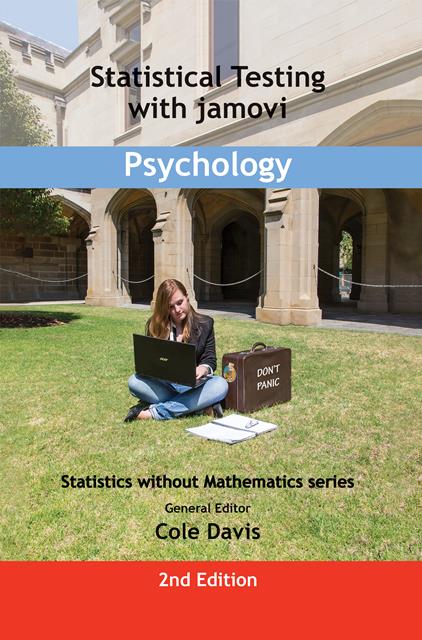|
| Home |
| Order books |

|
Statistical Testing with jamovi for Psychology
Statistical Testing with jamovi for Psychology
Exercises and case studies
Chapter 8 in the book contains basic exercises covering all of Section 2. Diverse tutors, however, have asked for traditional chapter by chapter exercises, hence the table immediately below. Further down the page, case studies are presented for readers who have finished reading the whole book, or their tutors.Exercises
These chapter by chapter exercises have been contributed by Marianne Vitug. For each chapter is a document with the questions, and one with the answers, with relevant spreadsheet files (with the .csv suffix). Each page opens in a new tab of your browser.
| Ch 2 Research design | Questions | Answer | self-entry |
| Ch 3 Descriptive statistics | Questions | Answers | data file 0 |
| Ch 4 Null hypothesis significance testing | Questions | Answers | data file 0 |
| Ch 5 Tests of differences | Questions | Answers | data file 1 |
| Ch 5 Tests of differences | data file 2 | ||
| Ch 5 Tests of differences | data file 3 | ||
| Ch 5 Tests of differences | data file 4 | ||
| Ch 6 Tests of relationships | Questions | Answers | data file |
| Ch 7 Categorical analyses | Questions | Answers | data file |
| Ch 10 Factorial ANOVA | Questions | Answers | data file 1 |
| Ch 10 Factorial ANOVA | data file 2 | ||
| Ch 10 Factorial ANOVA | data file 3 | ||
| Ch 11 ANCOVA | Questions | Answers | data file |
| Ch 12 MANOVA | Questions | Answers | data file |
| Ch 13 PCA and factor analysis | Questions | Answers | data file 1 |
| Ch 13 PCA and factor analysis | data file 2 | ||
| Ch 14 Logistic regression | Questions | Answers | data file |
| Ch 15 Partial correlations | Questions | Answers | data file |
| Ch 17 Bayesian statistics | Questions | Answers | data file |
| Ch 18 Survival analysis (Kaplan-Meier) | Questions | Answers | data file |
| Ch 19 Cluster analysis | Questions | Answers | data file |
Case studies
You have a selection of different measures derived from studies of bullying at school. Are there different types of bully?
Looking at a battery of results from different personality tests, you wish to see if the 'Big Five' still stands as the most robust model of describing personality.
Do people who suffer severe psychological stress after loss of a loved one have different psychological characteristics from those bereaved people who do not require treatment? You believe that age, ethnicity and gender may also affect the classification.
Is a type of counselling likely to differ in its effectiveness depending on the type of presenting problem? For example, if we used cognitive-behavioural therapy, would it have very different effects on people whose main symptoms were alcoholism, gambling addiction and panic attacks? Age, ethnicity and gender may affect the classification.
You are interested in the willingness of people to leave money to charities. Which psychological attributes lead to large, medium and small bequests? You may wish to consider attributes such as the number of close relatives with a related condition or experience, the age and social class of the respondents.
Kidd and Castano (2013) found that reading novels, as opposed to popular fiction, non-fiction and nothing at all, improved empathy, as represented by Theory of Mind skill. You want to try this design out with young people with behavioural problems and see it has an effect on social skills, attitudes and behaviour.
You are interested in how long it takes children in care to receive long-term fostering. Are there differences between age groups, or ethnicity, or behavioural problems, or whether or not children have been sexually abused?
Three groups of adults with depression attend different clinics. One group receives CBT, another psychoanalysis and a third Rogerian therapy. Are there significant differences in remission symptoms and is there a difference between male and female patients?
Recruiters were shown functional resumes (Brits: cv's) and asked to rate them in terms of employability. The documents had different skills levels, with photographs of differing levels of attractiveness and differing age groups.
Sales representatives try out three different techniques for opening a discussion. Which works best, and are there differences dependent on reps' personal attributes? (Or, perhaps, the potential customers' attributes.)
Are there particular categories of people who misuse accident and emergency services?
(Assume that there is no knowledge of the topic.)
Statistics without Mathematics series - General Editor: Cole Davis
ISBN numbers: Hardback - 978-1-915500-15-1 Paperback - 978-1-915500-16-8
Ebook - 978-1-915500-17-5
